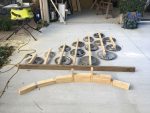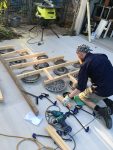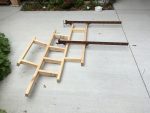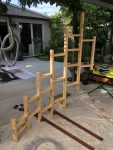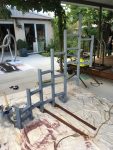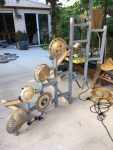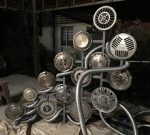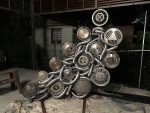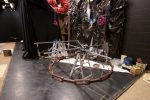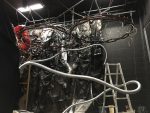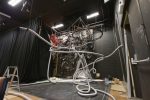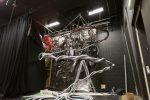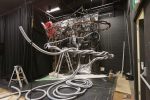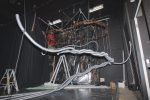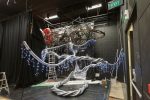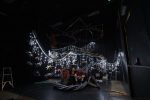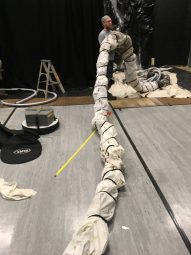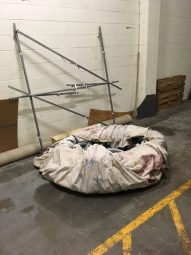Production Diary:
This is a dispassionate recording of the production of BØN541 v3.0, which was created to be an on-stage feature for the 2018 staging of the musical Rent at QPAC, Brisbane. It was a difficult project, and to be honest, I’m not really happy with the way the production handled their side of the process.
I’m publishing the details, knowing that doing so might have repercussions for me, because artists are too often the recipients of the short end of the stick, expected to work “for the exposure”, and stay silent when we’re mistreated by those with more power, for fear of losing future opportunities, for fear of being seen to be “difficult” if we speak out.
It’s time we stopped allowing that to happen to us.
It was a mistake on my part to do a “free” job. I wanted to help some people, who I’m sure had the best of intentions, get a project through. However, sculpture can’t be done on good intentions – it can be heavy, and therefore dangerous, and it requires a serious-minded professionalism, planning, and attention to detail.
When a budget is lacking, I’ve realised, it can also mean that professionalism is lacking, possibly through sheer inexperience.
Reflecting on the project, I don’t think anyone upstream of me had ever dealt with large sculpture as a part of their projects, and perhaps didn’t appreciate that when I said something required x number of days, or that I needed to know we had a workspace sorted, and what its characteristics were, before I started on a path building anything, that these were things I was saying as a trained professional in my field, whose concerns are safety and achievable timelines & scopes, and not just me being “a difficult finicky artist”.
So with that said…
The work was produced in three stages – the Base was assembled In Redcliffe, Brisbane over the course of four working days:
The next two days were spent organising gear, and looking around for a space at Noosa to do the construction on the Trunk. We were able to secure a space to work, but needed the production to supply, or fund, the necessary rigging equipment, and person, to hang it while work was underway.
The next 4 days were spent modifying and renewing the Truss at a storage space I rented in Noosa, while I waited for an answer on the rigging – during which time the production was able to organise a space, and a “rigging person”, in Brisbane.
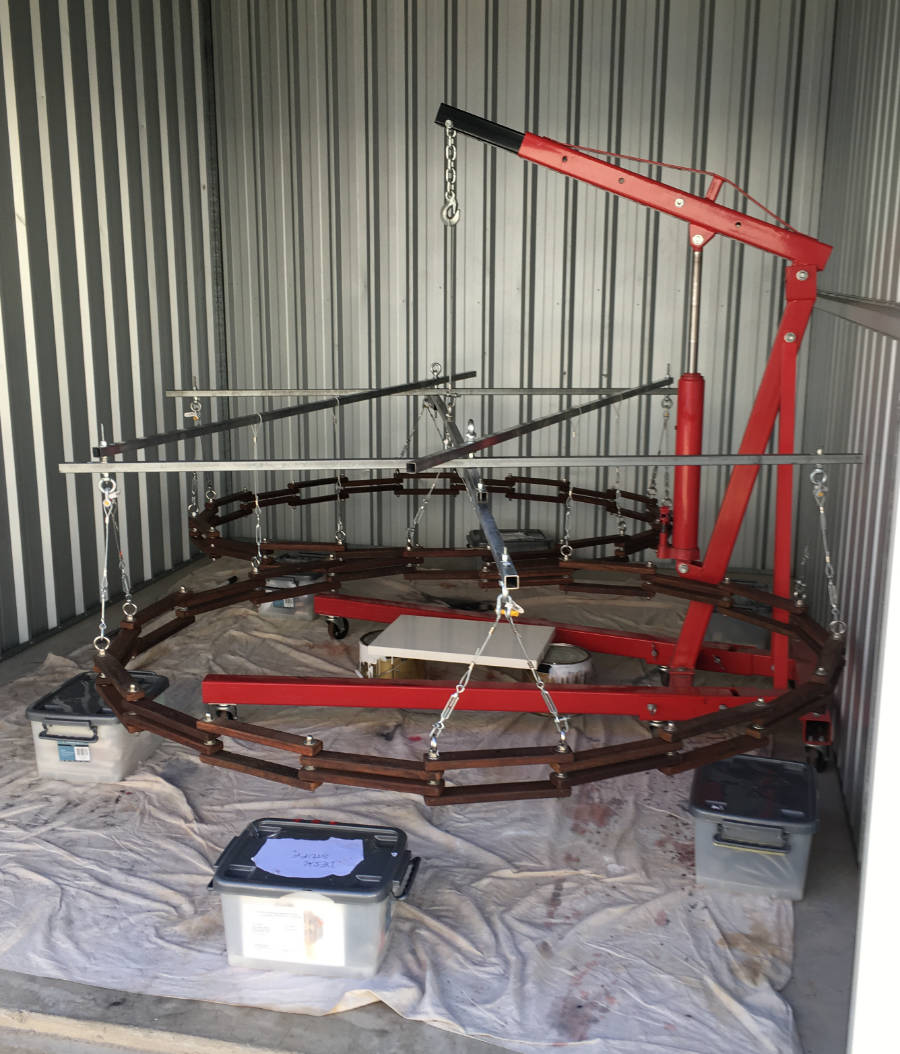
After a day’s travel down to Brisbane, I started construction on the Trunk at the Merivale Studios in Brisbane, where QPAC has a rehearsal space.
This is where major problems intruded upon the project…
Losing Control of The Situation, or The Danger of Relying on Others:
I had been told I would have 5 days in the workspace:
Day One:
Having been assured that hauling and rigging equipment was taken care of, we arrived at the workspace to find the “rigging” consisted of three non-hauling-rated ropes, slung over the metal lighting rail above our work location, and then over a second rail to create an offset vertical haul.
Anyone who has ever tried any sort of rigging should be able to see that as a hopeless exercise. The friction of the rope rubbing directly against the rail means that even if you can exert more weight on the rope than the thing you’re lifting, all you’re going to do is increase the rope’s friction against the rail, and the thing you’re lifting will go nowhere. Add to that, the rope had some elasticity – it was never going to work. It also wasn’t rated for safe hauling, and I was supposed to be relying on it suspending fifty kilograms of metal and wood above my head.
The other problem we faced on the first day was that a promised offer of an insurance indemnity was withdrawn when I presented it to be signed. The purpose of this indemnity was so that if anything I built failed, and the production’s insurer tried to cross-file against me for negligence, the liability would fall to the designer who had engaged me. The assurance that this indemnity would be provided was a specific agreement, and condition of my participation in the project.
Given it was a public holiday, we couldn’t contact the production to sort it with them, and I couldn’t contact my public liability insurer to get clarification. Also, the person responsible for organising the rigging couldn’t get any suitable equipment, so apart from a couple of hours setting up the truss and chain, we had our first day largely wasted.
Day Two:
The next day, I was able to get confirmation from my insurer, NAVA, that the work would be covered on the basis that I was its designer, and that it was clearly a stand-alone work of art, and recognisable as a part of my art practice, and not a work-for-hire activity on someone else’s project. I explained this to the designer as being the necessary condition under which I was able to remain engaged in the project. She agreed, and so we set about waiting for more news on the rigging situation.
After the production’s options were exhausted, I suggested the production call QPAC, the venue where the show was being held, and ask if they could lend us equipment. QPAC were happy to do so, and delivered the equipment I asked for – pulleys, sling straps and shackles.
At this point, I found out that our “rigger” wasn’t a ticketed, qualified rigger, and that I was going to have to design the positioning and geometry of all the equipment QPAC had provided. Working from memory of when I had used the same sort of gear to hoist Reconfigure, I was able to design the rigging configuration, and direct the haul to get the work secured above our heads.
Having spoken to people with rigging experience since, I discovered that the way certain parts were joined together by the supplied “rigger”, like connecting slings to extend their length, was done in a way that reduced their strength by 50%. I’m not a ticketed or trained rigger, and I feel very unsettled about this situation.
Next time, I will refuse to allow myself to work in a regulated trade outside of my qualification, or to work under something that is not hung by a ticketed rigger.
If the costume designer’s contribution fails, it’s a wardrobe malfunction. If my contribution fails, it’s a dead or crippled cast, crew, or, if on stage, audience member, depending on how it falls. I don’t think the gravity of that situation was ever really understood by the production.
The rest of the day was spent getting the main arm of the trunk in place, and planning out the positions of the other three arms.
Day Three:
After five hours sleep, our third day started with our first opportunity to actually see the theatre where the sculpture would be installed. After which, we had to get some more equipment, and then arrived back at the workspace to find there was a full rehearsal going on, with the QPAC leadership watching, so we were unable to get any work done until the afternoon. We worked through till night, when we had to leave to get more materials, which we were going to have to take to Redcliffe, spraypaint, then bring back to the city – an hour each way. After picking them up, we realised there wasn’t sufficient time, so we called it a night.
Day Four:
Our Fourth day, we had he space to ourselves, and powered through finishing the sculpture, and hanging the decorations, packing up around 9pm.
Day Five:
The final day, we lost most of because there was another full rehearsal, and we weren’t able to be there until 6:30 at night. That gave us around four hours to pack down the sculpture, including the chain and truss, and get it wrapped and safe for transport to the theatre the next morning for an 8am bumpin.
By the end of this night, I was literally in tears and vomiting with exhaustion and stress. I was sore, physically wrecked, and facing, at best, 5-6 hours sleep before a full day’s bumpin. I have a vague memory of drawing directions for my assistant in case I died in my sleep.
Of the 5 days worktime in the space the production had promised me, they had only delivered 3 in total, and one of those had already involved a 5 hours sleep turnaround.
I made the decision that I wasn’t going to be in for the 8am bumpin. I had managed to leave the truss more assembled than I had originally planned, and we weren’t scheduled to have a window with the QPAC rigging crew until 11am or later. So, I slept, and let my assistant take the base from Redcliffe, and the rest of the sculpture from the work space to QPAC, for which I’m eternally grateful.
Bumpin:
One of the dangers I had consistently warned about, was that building a site-specific work off-site, was going to mean the potential of unforeseen problems. The work was designed to be flexible in several ways, in order to deal with installation issues, however in order to preserve uninterrupted eyelines of the actors for the audience, the final form of the work was sadly compromised.
I spent a lot of time explaining to various people in the production what the consequences of making changes to the shape of the sculpture were – every time they wanted to move a branch, that change propagated throughout the work, necessitating re-tensioning all the hanging points, in order to keep the loading on the truss consistent and level.
Bumpin was a long day – we were there until closing time at 10pm, but we got it finished.
QPAC’s riggers were brilliant, and a joy to work with.
Knowing I wouldn’t be up to the hour drive back to Redcliffe afterwards, I had booked a couple of nights in a hotel at Southbank, to sleep and recover.
Final Thoughts:
There have been some significant lessons from this project:
- I was not paid, I was not on the profit-share. I donated the production thousands of dollars worth of artist’s fees, as well as lending them thousands of dollars of my equipment, for which I also didn’t charge them any rental. I agreed to that, on the understanding that:
- I would receive appropriate credit and acknowledgement for my contribution, which didn’t happen.
- I would be provided with a full insurance indemnity, which didn’t happen.
- I’m several hundred dollars out of pocket in expenses for upgrading the truss, car travel, and hotels necessitated for health reasons due to being overworked as a result of the production cutting our access to the workspace from 5 to 3 days.
- My credit was reduced from the agreed “Master Sculptor” to just “Sculptor“, and my credit was put in the Production section of the crew, not the Creative section, so there was no real recognition in the programme that I was actually responsible for the creative contribution of the tree.
- The thanks I received was an almost unreadable, postage-stamp sized reproduction of the larger image I had sent them, on the “thankyous” page of the brochure, for which there was plenty of wasted white space.
- Anyone reading the programme could be lead to believe the play’s Designer was responsible for my sculpture unless they notice my “thankyou” image is another of my Bonsai sculptures.
- Despite being the expert in my field, I was effectively ignored (until proven correct by events) every time I stated an opinion on how long things would take, what specific resources I’d need, and timelines for when I’d need them confirmed.
This might sound ungracious, but the simple fact is that Rent is going to be a sold out, and profitable project, and I am going to see none of that.
When people come out of the show, I suspect the tree is going to be one of the major things they talk about, and the production didn’t really pay out on their side of the “doing it for the exposure” bargain.
Remember, exposure is what you die from, when trapped on a mountainside.

